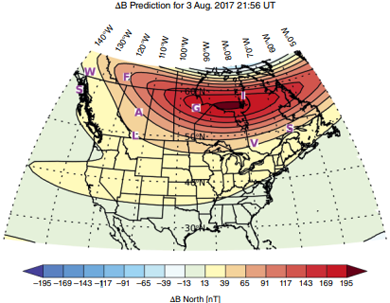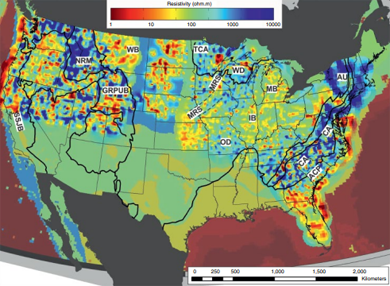Geomagnetic storms are a type of space weather event that can create geomagnetically induced currents (GICs) which, once they reach Earth’s surface, can interfere with power transmission transformers and other infrastructure. A new book, Geomagnetically Induced Currents from the Sun to the Power Grid, recently published by AGU, presents current knowledge about GIC prediction and impact. Here, one of the editors gives an overview of GIC hazards and the benefits of an interdisciplinary approach to addressing hazard and risk.
What are ‘geomagnetically induced currents’ and what impacts do they have on Earth’s surface?

Geomagnetic storms have a range of effects on the Earth’s magnetosphere, the ionosphere, and the thermosphere (part of the upper atmosphere).
They can also have effects on the ground when the rapidly changing geomagnetic field interacts with the solid Earth.
This includes creating GICs, which are potentially damaging quasi-DC currents that can arise in long conductors, such as power transmission lines or oil pipelines.
Is it possible to forecast GICs and predict their impacts?
GICs caused by geomagnetic storms can happen at any time but vary in frequency, strength, and impact. The most extreme geomagnetic storms are very rare but moderate-intensity storms are more common.

We can’t yet forecast the precise local impacts of GICs, but significant progress is being made in the space weather, geophysics, and power engineering communities to predict hazard conditions.
Scientists and power engineers are learning from these more common, moderate-intensity storms how to better understand, plan for and mitigate against disruptions due to GICs.
As the science advances and infrastructure risk is better understood, local forecasts will become more important in mitigation of potential GIC effects.
Why is an interdisciplinary approach to understanding GICs necessary but also a challenge?
GICs are a naturally interdisciplinary problem that involve processes from the Sun to the power grid, but the impacts are highly localized. It is an on-going challenge to bring together the broad areas of expertise in science and engineering that are needed to understand both the broad geophysical hazard and specific infrastructure risk.
What does your new book offer to people interested in this topic?

This book covers a range of topics relevant to GICs, from geoscience to power engineering, and from the space weather driver to power grid impacts.
The introductory and deeper-dive chapters can be useful to those interested in learning about the full GIC problem, whether they are new to the topic or a domain expert looking to better understand an adjacent discipline.
Geomagnetically Induced Currents from the Sun to the Power Grid, 2019, ISBN: 978-1-119-43438-2, list price, $199.95 (hardcover), $159.99 (e-book)
—Jennifer L. Gannon ([email protected]; ![]() 0000-0001-5524-6452), Computational Physics, Inc., USA
0000-0001-5524-6452), Computational Physics, Inc., USA
Editor’s Note: It is the policy of AGU Publications to invite the authors or editors of newly published books to write a summary for Eos Editors’ Vox.
Citation:
Gannon, J. L. (2019), The infrastructure impacts of solar storms, Eos, 100, https://doi.org/10.1029/2019EO135665. Published on 22 October 2019.
Text © 2019. The authors. CC BY-NC-ND 3.0
Except where otherwise noted, images are subject to copyright. Any reuse without express permission from the copyright owner is prohibited.

